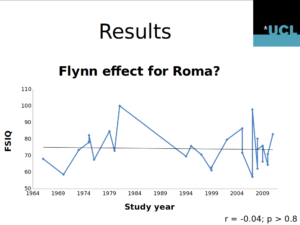I recently read the biography of William Shockley. Basically, I am reading biographies of prominent researchers to gain an understanding of them. I was also thinking of writing one about Arthur Jensen, having already set up a website for him and read most of his writings and writings about him.
https://www.goodreads.com/book/show/537597.Broken_Genius
The book is written by a journalist with a poor understanding of differential psychology, so he is critical against IQ testing at various places in the book. Just ignore that. It is however curious that Shockley took a number of IQ tests and never scored particularly highly: scores i the 120-130 region, yet people described him as very bright. My guess for this is that his score was very tilted. A high level of general cognitive ability + strong tilt + test ceilings will mean that the test have a downward bias. This is because your strong abilities will reach the ceiling and thus get downward biased while the weaker abilities will not and thus be accurately measured. The average of no bias and downward bias is some downward bias.
Shockley sounds like a person who would have a strong tilt. My reasoning is based on the stereotype that people in tech have weaker social abilities and are tilted away from verbal abilities. I don’t have any good evidence for the first, but see this post for the second. A second part of my reasoning is that Shockley was extremely insensitive. My hypothesis is that interpersonal sensitivity is correlated with a verbal tilt. This holds between the genders for instance (women higher in both), my hypothesis is simply that it is a more general pattern that holds within genders too. I am not familiar with any strong evidence for this.
Aside from various youtube vidoes one can find of him debating IQ and race on TV in the 60s and 70s, here’s a quote illustrating his insensitivity:
The late William Shockley once spoke of Nature as having “color-coded groups of individuals so that statistically reliable predictions of their adaptability to intellectually rewarding and effective lives can easily be made and profitably be used by the pragmatic man in the street” (Shockley, 1972, p. 307). This was an unfortunate choice of metaphor, from at least two standpoints. First, it is misleading in a very fundamental way. The point of color coding electrical or electronic components is to let the user know what the internal characteristics of the device are from the external color code. The scheme works because the user can trust manufacturers to supply components bearing a given color code that are uniform in the coded-for property, and distinct from components of other colors. If electrical and electronics manufacturers did as badly as Nature apparently has–so that components bearing any color code varied widely among themselves, and overlapped extensively with components of other color codes–users would abandon the color coding as worthless, and resort to direct tests on the components themselves to find one that in fact possesses the properties desired.
A second objection to the metaphor is that it is value-laden, and the values are not very sympathetic ones. Why should ordinary people, of any color, be equated to simple electrical or electronic components whose only role is as interchangeable parts in more complex systems, and why should Nature be arranging things for the benefit of personnel managers anyway? I venture to say that if Professor Shockley–or you or I – – h a d written down the quoted sentence and then stopped to think whether it might give a misleading impression or unintended offense, you or I – – a n d perhaps even Professor Shockley–would have wound up saying it differently.
The quote is from the little known editorial by Loehlin: Should we do research on race differences in intelligence
I propose the same explanation for another socially odd, but smart person who did not score particularly high on tests: Richard Feymann.
I have written to Thomas Coyle to hear if he knows about any studies about these proposed relationships.


